
Gondwana, also known as Gondaranya, is a region of India, named after the Gondi people who live there. The name of the ancient continent of Gondwanaland was derived from Gondwana, because some of the earliest rock formations of this continent were first investigated in part of the region, in modern Odisha.

Bundelkhand is a geographical and cultural region and a proposed state and also a mountain range in central & North India. The hilly region is now divided between the states of Uttar Pradesh and Madhya Pradesh, with the larger portion lying in the latter state.

Sagar (Saugor) is a city, municipal corporation and administrative headquarter in Sagar district of the state of Madhya Pradesh in central India. Situated on a spur of the Vindhya Range, 1,758 feet (536 m) above sea-level. The city is around 172 kilometres (107 mi) northeast of state capital, Bhopal.
Mandla is a city with municipality in Mandla district in the Indian state of Madhya Pradesh. It is the administrative headquarters of Mandla District. The city is situated in a loop of the Narmada River, which surrounds it on three sides, and for 15 miles between Mandla and Ramnagar, Madhya Pradesh the river flows in a deep bed unbroken by rocks. The Narmada is worshiped here, and many ghats have been constructed on the banks of the river. It was a capital of the Gondwana Kingdom who built a palace and a fort, which in the absence of proper care have gone to ruins.

Damoh is a city in the Indian state of Madhya Pradesh. The city is also the district headquarters of Damoh district.
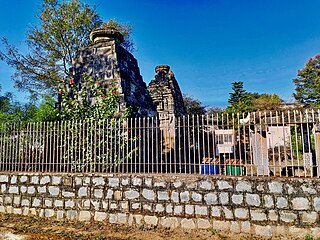
Balaghat district is a district of Madhya Pradesh state in Central India. The town of Balaghat serves as its administrative headquarters.
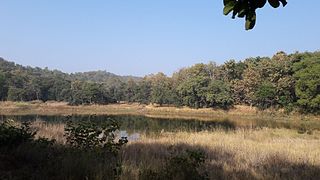
Seoni District is a district of Madhya Pradesh state in central India. The town of Seoni is the district headquarters.

Sagar district is a district of Madhya Pradesh state in central India. The town of Sagar serves as its administrative center.

The Saugor and Nerbudda Territories, was a region of British India, located in the central part of present-day Madhya Pradesh state in central India. It included the present-day districts of Sagar (Saugor), Damoh, Jabalpur, and Narsinghpur.
Bijawar is a city the state of Madhya Pradesh, India. It is the administrative headquarters of Bijawar Taluk, and was formerly the capital of a princely state of British India of the same name. The people of Bijawar are demanding the district status from their state government. It is the 53rd proposed district of Madhya Pradesh
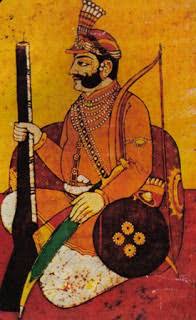
Chhatrasal Bundela was an Indian warrior and ruler from the Bundela Rajput clan, who fought against the Mughal Empire, and established his own kingdom in Bundelkhand during the 17th-18th centuries.
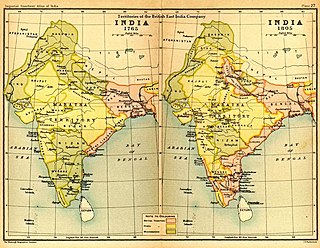
The Maratha Conquests were a series of conquests in the Indian subcontinent which led to the building of the Maratha Empire. These conquests were started by Shivaji in 1659, from the victory at the Battle of Pratapgad against Bijapur. The expansion of the empire was limited and interrupted by the Mughal conquests of south India by Mughal emperor Aurangzeb. Marathas were forced to defend their territories against the overwhelmingly strong Mughal army in the 27 years long Deccan wars. They were able to defend their territories and gain an upper hand over Mughals in the sustained conflict.
Govind Ballal Kher, historically known as Govind Pant Bundela, was a Military General of Peshwas in Northern India during 1733 to 1760. Peshwa Bajirao appointed him his trustee for the 1/3 kingdom rewarded to him by Maharaja Chhatrasal in Bundelkhand. He ruled the city of Kalpi and later it was given as jagir to his descendant Nana Govinda Rao. After this Govind Rao ruled the Jalaun State.

The history of Nagpur, in central India, spans over 5,000 years, including the Kingdom of Nagpur in the 18th and 19th century. Human existence around present-day Nagpur city can be traced back 3,000 years to the 8th century BC. Menhir burial sites at Drugdhamna indicate megalithic culture existed around Nagpur and is still followed in present times.
The Battle of Jaitpur was fought between the Maratha Empire under Peshwa Baji Rao I, on behalf of Chhatrasal Bundela, the ruler of Bundelkhand; and the Mughal empire under of Muhammad Khan Bangash in March 1729. Bangash attacked the state of Bundelkhand in December 1728. Being too old to fight, as well as heavily outnumbered, Chhatrasal appealed Baji Rao for assistance- under whose leadership the Maratha-Bundela alliance defeated Bangash at Jaitpur.
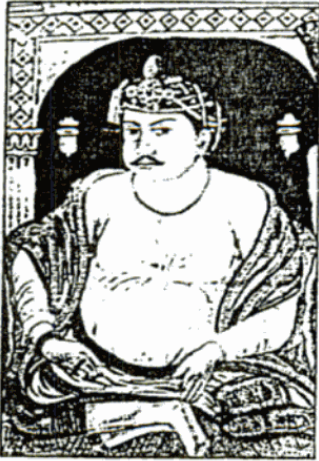
Bakht Buland Shah was a ruler of the Rajgond dynasty. He added to his kingdom, the territories of Chanda and Mandla, and portions of Nagpur, Balaghat, Seoni, Bhandara and the adjoining Rajput kingdom of Kherla/Khedla. The present districts of Chhindwara and Betul also fell under his control. A great warrior, he went on to conquer Pauni, Dongartal, Sivni & Katangi.

Bijawar State was a princely state of colonial India, located in modern Chhatarpur district of Madhya Pradesh.

Panna State was a princely state of colonial India, located in modern Panna district of Madhya Pradesh.
The Garha Kingdom, also called Garha Mandla or Garha Katanga was part of the northern portion of Gondwana.
Hridayshah, also called Hirde Shah, was the 54th and last great king of Garha-Mandla. Hridayshah was a great patron and lover of music, and wrote the musical compostions of "Hriday Koutuk" and "Hriday Prakash" in 1660. He moved his kingdom's capital from Chouragarh to Ramnagar of Mandla district to secure it from Bundela attacks.













